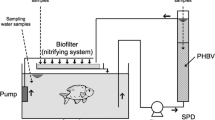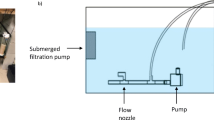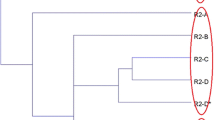Abstract
A denitrification reactor packed with polycaprolactone (PCL) as a carbon source and biofilm carrier was developed to remove nitrate nitrogen (\( {\mathrm{NO}}_3^{-}-\mathrm{N} \)) from the water of a recirculating aquaculture system for 115 days. The hydraulic retention time was set to 6 h, and the water flow rate was 0.95 L h−1. The removal rates of \( {\mathrm{NO}}_3^{-}-\mathrm{N} \) ranged from 34.67 to 155.7 g \( {\mathrm{NO}}_3^{-}-\mathrm{N} \) m−3 day−1 when the effluent \( {\mathrm{NO}}_3^{-}-\mathrm{N} \) concentrations ranged between 1.62 and 72.25 mg L−1. No obvious changes in the Fourier transform infrared spectra of the PCL before and after use were observed. Bacterial community structure in the biofilm of the PCL granules was analyzed using Illumina MiSeq sequencing technology. Proteobacteria and Bacteroidetes were predominant in the biofilm, with relative abundances of 63.9 and 27.4%, respectively. Three genera, Acidovorax, Azospira, and Diaphorobacter, were capable of both denitrification and PCL degradation. This study indicates that PCL-packed reactors may be used and optimized for removing nitrate from aquaculture effluents.






Similar content being viewed by others
References
Boley A, Müller WR, Haider G (2000) Biodegradable polymers as solid substrate and biofilm carrier for denitrification in recirculated aquaculture systems. Aquac Eng 22(1–2):75–85
Boley A, Mergaert J, Müller C et al (2003) Denitrification and pesticide elimination in drinking water treatment with the biodegradable polymer poly (ε-caprolactone) (PCL). Acta Hydrochim Hydrobiol 31(3):195–203
Chris GJ, van Bussel P, Schroeder JP et al (2012) The chronic effect of nitrate on production performance and health status of juvenile turbot (Psetta maxima). J Aquaculture 326:163–167
Chu L, Wang J (2011) Comparison of polyurethane foam and biodegradable polymer as carriers in moving bed biofilm reactor for treating wastewater with a low C/N ratio. Chemosphere 83:63–68
Chu L, Wang J (2013) Denitrification performance and biofilm characteristics using biodegradable polymers PCL as carriers and carbon source. Chemosphere 91:310–1316
Colson V, Sadoul B, Valotaire C et al (2015) Welfare assessment of rainbow trout reared in a recirculating aquaculture system: comparison with a flow-through system. Aquaculture 436:151–159
Davidson J, Good C, Welsh C et al (2014) Comparing the effects of high vs. low nitrate on the health, performance, and welfare of juvenile rainbow trout Oncorhynchus mykiss within water recirculating aquaculture systems. Aquac Eng 59:30–40
Gómez MA, Hontoria E, González-López J (2002) Effect of dissolved oxygen concentration on nitrate removal from groundwater using a denitrifying submerged filter. J Hazard Mater 90:267–278
Horiba Y, Khan ST, Hirashi A (2005) Characterization of the microbial community and culturable denitrifying bacteria in a solid-phase denitrification process using poly(ɛ-caprolactone) as the carbon and energy source. Microbes Environ 20(1):25–33
Jia SY, Han HJ, Zhuang HF et al (2015) Impact of high external circulation ratio on the performance of anaerobic reactor treating coal gasification wastewater under thermophilic condition. Bioresour Technol 192:507–513
Karanasios K, Vasiliadou I, Tekerlekopoulou A et al (2017) Effect of C/N ratio and support material on heterotrophic denitrification of potable water in bio-filters using sugar as carbon source. Int Biodeter Biodeg 111:62–73
Khan ST, Horiba Y, Takahashi N et al (2007) Activity and community composition of denitrifying bacteria in poly (3-hydroxybutyrate-co-3-hydroxyvalerate)—using solid-phase denitrification processes. Microbes Environ 22(1):20–31
Lee KC, Rittmann BE (2003) Effects of pH and precipitation on autohydrogenotrophic denitrification using the hollow-fiber membrane-biofilm reactor. Water Res 37:1551–1556
Li P, Zuo J, Zhao J et al (2016) Tertiary nitrogen removal for municipal wastewater using a solidphase denitrifying biofilter with polycaprolactone as the carbon source and filtration medium. Water Res 93:74–83
Luo GZ, Xu GM, Gao JF et al (2016a) Effect of dissolved oxygen on nitrate removal using polycaprolactone as an organic carbon source and biofilm carrier in fixed-film denitrifying reactors (a). J Environ Sci 43(5):147–152
Luo GZ, Xu GM, Tan HX et al (2016b) Effect of dissolved oxygen on denitrification using polycaprolactone as both the organic carbon source and the biofilm carrier. Int Biodeter Biodeg 110:155–162
Martins CIM, Eding EH, Verdegem MCJ et al (2010) New developments in recirculating aquaculture systems in Europe: a perspective on environmental sustainability. Aquac Eng 43:83–93
Mergaert J, Boley A, Cnockaert MC et al (2001) Identity and potential functions of heterotrophic bacterial isolates from a continuous-up flow fixed-bed reactor for denitrification of drinking water with bacterial polyester as source of carbon and electron donor. Syst Appl Microbiol 24(2):303–310
Morris AL, Hamlin HJ, Francis-Floyd R et al (2011) Nitrate induced goiter in captive white spotted bamboo sharks Chiloscyllium plagiosum. J Aquat Anim Health 23:92–99
Müller WR, Wurmthaler J, Heinemann A (1992) Biologische nitrate limination in kleinen wasserwerken (biological nitrate elimination in small drinking water treatment plants). WAP 5:231–235
Qi Z, Zhang X, Boon N et al (2009) Probiotics in aquaculture of China—current state, problems and prospect. Aquaculture 290:15–21
Rodrigues AL, Machado AV, Nobrega JM et al (2014) A poly-epsilon-caprolactone based biofilm carrier for nitrate removal from water. Int J Environ Sci Technol 11(2):263–268
Saliling WJB, Westerman PW, Losordo TM (2007) Wood chips and wheat straw as alternative biofilter media for denitrification reactors treating aquaculture and other wastewaters with high nitrate concentrations. Aquac Eng 37:222–233
Schneider O, Chabrillo-Popelk M, Smidt H et al (2007) HRT and nutrients affect bacterial communities grown on recirculation aquaculture system effluents. FEMS Microbiol Ecol 60:207–219
SEPA (2004) Report on the state of the environment in China. Available at: http://www.zhb.gov.cn/english/SOE/soechina2004/index.htm
Shen ZQ, Wang JL (2011) Biological denitrification using cross-linked starch/PCL blends as solid carbon source and biofilm carrier. Bioresour Technol 102(19):8835–8838
Shen ZQ, Zhou YX, Hu J et al (2013) Denitrification performance and microbial diversity in a packed-bed bioreactor using biodegradable polymer as carbon source and biofilm support. J Hazard Mater 250-251:431–438
Shnel N, Barak Y, Ezer T et al (2002) Design and performance of a zero-discharge tilapia recirculating system. Aquac Eng 26:191–203
Snyder AR, Williams HN, Baer ML et al (2002) 16S rDNA sequence analysis of environmental Bdellovibrio-and-like organisms (BALO) reveals extensive diversity. Int J Syst Evol Microbiol 52:2089–2094
van Rijn J (2013) Waste treatment in recirculating aquaculture systems. Aquacul Eng 53:49–56
van Rijn J, Tal Y, Schreier HJ (2006) Denitrification in recirculating systems: theory and applications. Aquac Eng 34:364–376
Wang XM, Wang JL (2009) Removal of nitrate from groundwater by heterotrophic denitrification using the solid carbon source. Sci Chin Ser B 52(2):236–240
Wang Z, Fei X, He S et al (2017) Comparison of heterotrophic and autotrophic denitrification processes for treating nitrate-contaminated surface water. Sci Total Environ 579:1706–1714
Wu W, Yang F, Yang L (2012) Biological denitrification with a novel biodegradable polymer as carbon source and biofilm carrier. Bioresour Technol 118:136–140
Wu WZ, Yang LH, Wang JL (2013) Denitrification using PBS as carbon source and biofilm support in a packed-bed bioreactor. Environ Sci Pollut Res 20(1):333–339
Zhang Q, Ji F, Xu X (2016) Effects of physicochemical properties of poly-e-caprolactone on nitrate removal efficiency during solid-phase denitrification. Chem Eng J 283:604–613
Funding
This study was funded by the Shanghai Science and Technology Commission Project (16DZ2281200).
Author information
Authors and Affiliations
Corresponding author
Rights and permissions
About this article
Cite this article
Luo, G., Liu, Z., Gao, J. et al. Nitrate removal efficiency and bacterial community of polycaprolactone-packed bioreactors treating water from a recirculating aquaculture system. Aquacult Int 26, 773–784 (2018). https://doi.org/10.1007/s10499-018-0251-5
Received:
Accepted:
Published:
Issue Date:
DOI: https://doi.org/10.1007/s10499-018-0251-5




